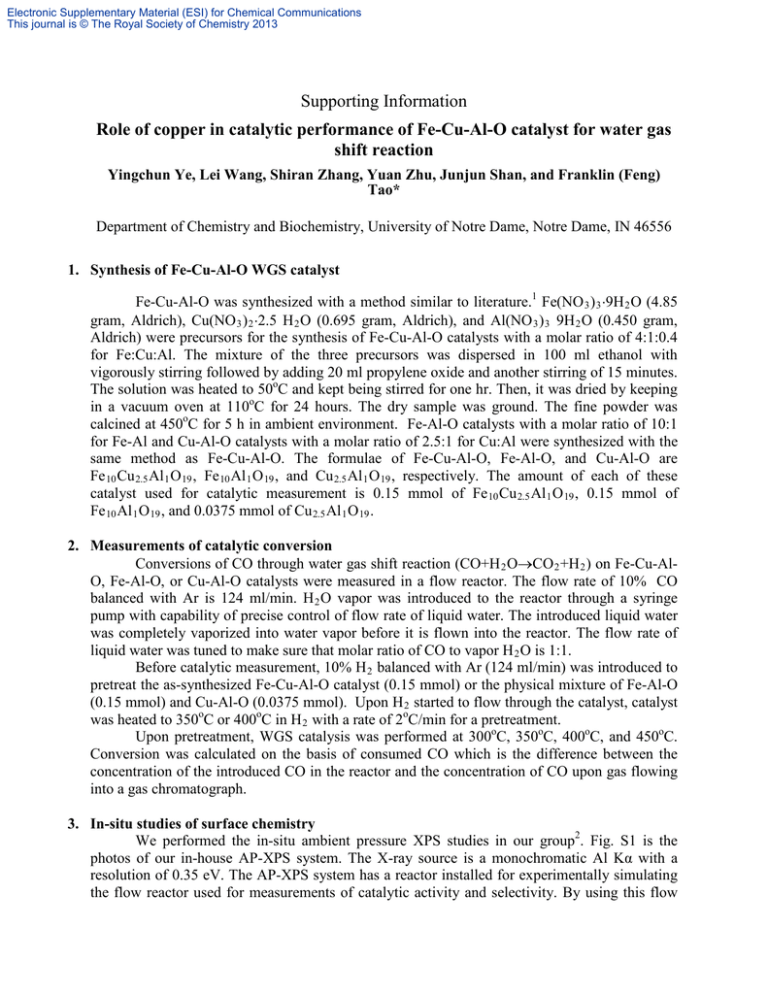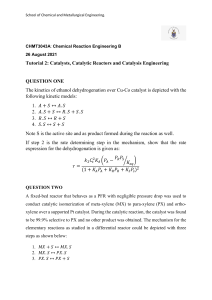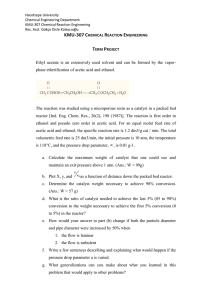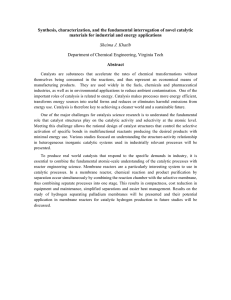Supporting Information Role of copper in catalytic performance of Fe
advertisement

Electronic Supplementary Material (ESI) for Chemical Communications This journal is © The Royal Society of Chemistry 2013 Supporting Information Role of copper in catalytic performance of Fe-Cu-Al-O catalyst for water gas shift reaction Yingchun Ye, Lei Wang, Shiran Zhang, Yuan Zhu, Junjun Shan, and Franklin (Feng) Tao* Department of Chemistry and Biochemistry, University of Notre Dame, Notre Dame, IN 46556 1. Synthesis of Fe-Cu-Al-O WGS catalyst Fe-Cu-Al-O was synthesized with a method similar to literature.1 Fe(NO 3 ) 3 ⋅9H 2 O (4.85 gram, Aldrich), Cu(NO 3 ) 2 ⋅2.5 H 2 O (0.695 gram, Aldrich), and Al(NO 3 ) 3 9H 2 O (0.450 gram, Aldrich) were precursors for the synthesis of Fe-Cu-Al-O catalysts with a molar ratio of 4:1:0.4 for Fe:Cu:Al. The mixture of the three precursors was dispersed in 100 ml ethanol with vigorously stirring followed by adding 20 ml propylene oxide and another stirring of 15 minutes. The solution was heated to 50oC and kept being stirred for one hr. Then, it was dried by keeping in a vacuum oven at 110oC for 24 hours. The dry sample was ground. The fine powder was calcined at 450oC for 5 h in ambient environment. Fe-Al-O catalysts with a molar ratio of 10:1 for Fe-Al and Cu-Al-O catalysts with a molar ratio of 2.5:1 for Cu:Al were synthesized with the same method as Fe-Cu-Al-O. The formulae of Fe-Cu-Al-O, Fe-Al-O, and Cu-Al-O are Fe 10 Cu 2.5 Al 1 O 19 , Fe 10 Al 1 O 19 , and Cu 2.5 Al 1 O 19 , respectively. The amount of each of these catalyst used for catalytic measurement is 0.15 mmol of Fe 10 Cu 2.5 Al 1 O 19 , 0.15 mmol of Fe 10 Al 1 O 19 , and 0.0375 mmol of Cu 2.5 Al 1 O 19 . 2. Measurements of catalytic conversion Conversions of CO through water gas shift reaction (CO+H 2 O→CO 2 +H 2 ) on Fe-Cu-AlO, Fe-Al-O, or Cu-Al-O catalysts were measured in a flow reactor. The flow rate of 10% CO balanced with Ar is 124 ml/min. H 2 O vapor was introduced to the reactor through a syringe pump with capability of precise control of flow rate of liquid water. The introduced liquid water was completely vaporized into water vapor before it is flown into the reactor. The flow rate of liquid water was tuned to make sure that molar ratio of CO to vapor H 2 O is 1:1. Before catalytic measurement, 10% H 2 balanced with Ar (124 ml/min) was introduced to pretreat the as-synthesized Fe-Cu-Al-O catalyst (0.15 mmol) or the physical mixture of Fe-Al-O (0.15 mmol) and Cu-Al-O (0.0375 mmol). Upon H 2 started to flow through the catalyst, catalyst was heated to 350oC or 400oC in H 2 with a rate of 2oC/min for a pretreatment. Upon pretreatment, WGS catalysis was performed at 300oC, 350oC, 400oC, and 450oC. Conversion was calculated on the basis of consumed CO which is the difference between the concentration of the introduced CO in the reactor and the concentration of CO upon gas flowing into a gas chromatograph. 3. In-situ studies of surface chemistry We performed the in-situ ambient pressure XPS studies in our group2. Fig. S1 is the photos of our in-house AP-XPS system. The X-ray source is a monochromatic Al Kα with a resolution of 0.35 eV. The AP-XPS system has a reactor installed for experimentally simulating the flow reactor used for measurements of catalytic activity and selectivity. By using this flow Electronic Supplementary Material (ESI) for Chemical Communications This journal is © The Royal Society of Chemistry 2013 reactor of the AP-XPS, product molecules do not accumulate and thus reabsorb on the surface of the catalyst. A catalyst was loaded on HOPG surface for in-situ AP-XPS studies in a flow reactor. Gases were introduced to the reactor through mass flow controllers. The flow rates of CO and H 2 O vapor are 6 ml/min and 6 ml/min, respectively. Fe 2p and Cu 2p photoemission features were collected during pretreatment in H 2 at 350oC or 400oC and during catalysis at 300oC, 350oC, 400oC, and 450oC. Binding energies of Fe 2p and Cu 2p were calibrated with C1s of HOPG. 4. XRD pattern of Fe-Cu-Al-O catalyst (1 1 9) (2 0 6) 20 30 Fe-Cu-Al-O (Fe:Cu=4:1) (0 0 12) 40 (4 0 12) (1 1 15) 50 60 70 2θ (o) The above is the XRD pattern. The assigned peaks are diffraction patterns of Fe 2 O 3 . No CuO or Cu 2 O was found. 1. 2. L. Zhang, X. Wang, J.-M. M. Millet, P. H. Matter and U. S. Ozkan, Applied Catalysis a-General, 2008, 351, 1-8. F. Tao, Chemical Communications, 2012, 48, 3812-3814.





